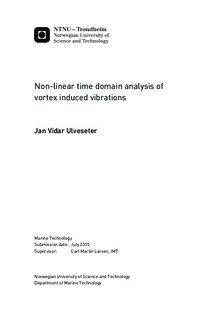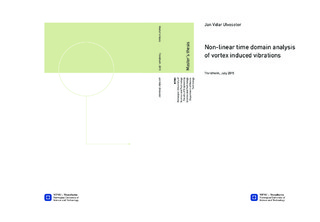| dc.description.abstract | In this thesis a model for nonlinear analysis of vortex induced vibrations (VIV), applied to free spanning pipelines, is proposed. The developed model takes into account the soil-pipe interaction. Through case studies, conclusions can be drawn toward the influence of nonlinear soil-pipe interaction, compared to linear prediction tools. Soil-pipe interaction is important to consider because of VIV induced bending stresses at the pipe shoulders. The fatigue damage at the span shoulders can be a limiting factor for lifetime estimations of pipelines. Hence a reliable model, including nonlinear soil dampers and soil springs, is necessary for realistic results.
The nonlinear analysis program is created in MATLAB. It is based on Mats Thorsen s linear time domain VIV model for analysis of simple supported beams. To make it applicable for free spanning pipelines, a seabed profile and the pipeline static configuration, must be found. RIFLEX is used to find the static configuration. When the seabed and static configuration is known, soil dampers and soil springs can be added to the vertical translation degrees of freedom at positions of soil penetration.
The proposed program has the option of a linear or a nonlinear analysis. They are referred to as Ulveseter s linear model and Ulveseter s nonlinear model, respectively. If the linear analysis is chosen, the stiffness and damping matrices are based on the static configuration, and are constant throughout the time integration. By updating the stiffness and damping matrices for every time step of the time integration, it is possible to switch the soil springs and soil dampers off, when the pipeline lifts up from the seabed. They can be turn on again in case of seabed penetration. This is how the nonlinear soil-pipe interaction is established.
Ulveseter s nonlinear model is compared to Ulveseter s linear model and VIVANA. Through six case studies predictions of response amplitudes and stress amplitudes are found for a variation of pipeline data, seabed profiles, soil stiffness values, soil damping values and current velocities. The results show that the stress amplitudes at the pipe shoulders are reduced for the nonlinear model. The soil damping has a small influence on the response predictions for most cases. The seabed curvature around the pipe shoulders influences the touch down point position for Ul- veseter s nonlinear model. Less seabed curvature makes the touch down point vary more than in case of a large curvature. Increasing soil stiffness is observed to increase the stress amplitudes. It can also trigger a mode shift, as seen for Ulveseter s linear model. Increased current velocity results in a mode shift of the response shape. Ulveseter s model compares well to VIVANA, but predicts in most cases somehow smaller stress and response values than VIVANA.
Concerning the influence of soil damping, it may depend on the pipeline properties, seabed profile and current conditions. It is only the first case study where the soil damping influence is of significance for all VIV models. This case is based on a shorter pipe, with less bending stiffness, with less end tension facing a stronger current, than the other cases. Also, the seabed profile has a smaller curvature at the pipe shoulders than the rest of the cases. However, Case 1 is based on an extreme current velocity and the pipe tension is low compared to bending stiffness and and dimensions of the pipe. Hence, for the more realistic cases, the soil damping is of less importance for the response. In Case 3 and 4, the soil damping effect is larger for Ulveseter s nonlinear model, than the linear prediction tools. However, the result might be influenced by transient effects.
However, Case 1 is based on an extreme current velocity and the pipe tension is low compared to bending stiffness and and dimensions of the pipe. Hence, for all realistic cases, the soil damping is not important for the response. In Case 3 and 4, the soil damping effect is larger for Ulveseter s nonlinear model, than the linear prediction tools. However, the result might be influenced by transient effects.
The proposed nonlinear program is limited to look at cross-flow motion only. Axial degrees of freedom are neglected because they are considered to be of secondary importance. The only nonlinearity accounted for is the soil-pipe interaction. Tension variations, large displacements and nonlinear material properties are not considered. A fully nonlinear analysis should include both static and dynamic forces in the dynamic analysis. Because the proposed model uses the static configuration found from RIFLEX, this is not possible to do in a consistent way. Therefore an approximation is performed to account for the effect of gravity. To improve the present work, Ulveseter s model should be modified to account for these limitations. | |

